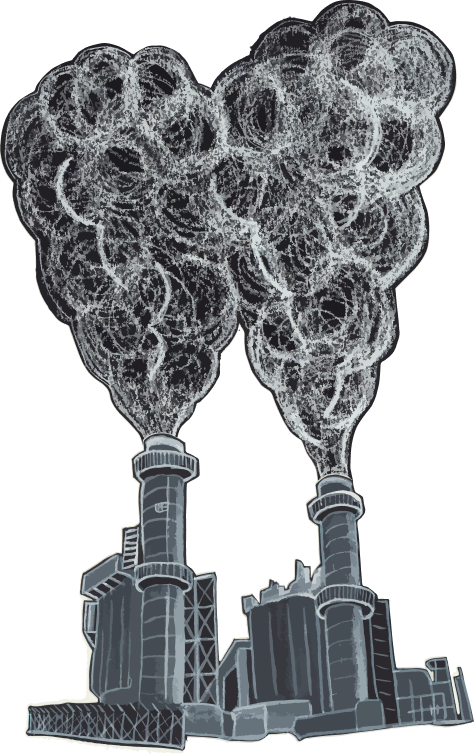North Dakota
Back to mapTo get to zero by 2050, North Dakota must cut emissions by 3.7% a year
Emissions in North Dakota
Million metric tons of carbon dioxide (CO2) [?] equivalent (MTCO2e [?]) emissions
Note: Grey area indicates missing data due to processing delays.
Source: WRI, Mar 2021
This is how we're going to do it
- Boilers and furnaces with heat pumps [?]
- Gas stoves with electric induction stoves [?]
- No-till farming to keep CO2 in the soil
- Capturing methane leaks from landfills
- Capturing CO2 to make emissions-free concrete
- Burning green hydrogen to make emissions-free steel
- Plugging methane leaks from gas pipelines
Decarbonize Our Buildings
3% of North Dakota's climate pollution comes from buildings.
We burn fossil fuels to heat our air, water, and food.
To cut this pollution...
Let's electrify our heat!
We'll replace...
...in all of North Dakota's 568,000 buildings.
In fact, 43% of appliances in buildings in North Dakota are already fossil fuel free!
That means we only need to electrify the remaining 327,000 dirty buildings in North Dakota. That's around 12,000 per year.
Source: Microsoft, Mar 2021; NREL, Dec 2021Electrifying all buildings cuts 3% of the pollution.
Decarbonize Our Transport
10% of North Dakota's pollution comes from cars, trucks, trains, and planes.
But mostly from cars.
To cut this pollution,
your next car must be electric.
Or consider going car-free with public transit, bikes/e-bikes, car share, or other alternatives!
There are 216,000 vehicles in North Dakota and 220 are already electric (0.1% of the total).
We need to electrify (or replace) the remaining 215,000 gas-powered vehicles. That's around 8,000 a year.
Source: DOT, Feb 2021Electrifying all transportation cuts 10% of the pollution.
Decarbonize Our Power
33% of North Dakota's pollution comes from burning coal, gas, and oil to make power.

To cut this pollution...
Put solar panels on your roof!
Then, we'll replace all fossil fuel power plants with solar and wind farms.

...and find good jobs for those workers.
Current Fossil Fuel Power Plants in North Dakota
7 coal plants
Coal Creek
McLean County
1,218 MW
Antelope Valley
Mercer County
954 MW
Milton R Young
Oliver County
734 MW
Leland Olds
Mercer County
656 MW
Coyote
Mercer County
450 MW
R M Heskett
Morton County
291 MW
Spiritwood Station
Stutsman County
106 MW
2 gas plants
Lonesome Creek Station
McKenzie County
303 MW
Pioneer Generating Station
Williams County
293 MW
5 oil plants
Jamestown
Stutsman County
48 MW
Hillsboro
Traill County
4 MW
Kindred School
Cass County
2 MW
Portable Generator 2
Williams County
2 MW
Portable Generator 3
Williams County
2 MW
But wait!
It's not enough to replace our power plants with wind and solar farms.
To power our electric cars and buildings, we need two times the electricity we have today.
In all, we'll need to build 2,000 megawatt (MW) [?] of wind power and 2,000 MW of solar power.
Since the average wind turbine provides 2.75 MW of peak capacity, North Dakota would need to install about 716 turbines.
Since North Dakota already has 2,000 MW of wind and 0 MW of solar, that's 308 MW of wind power we need to build and 2,000 MW of solar power. That's around 11 MW of wind power and 81 MW of solar power a year.
Source: EIA, Apr 2022Decarbonizing all dirty power cuts 33% of the pollution.
And gives us zero-emissions power we need to eliminate pollution from buildings and cars!
Other Emissions
The last 54% of North Dakota's climate pollution comes from other sources...
This includes farming, landfills, industry, and leaks from gas pipelines.
There's no one solution to solve these problems, but there are lots of great ideas:
That doesn't mean there's no solution, it just means that clean electrification [?] doesn't help with these problems, and you could fill a whole book with covering all of them. We need to encourage our politicians to invest in researching new solutions and implementing existing solutions to these problems!
Ready to do your part?
Learn how to electrify your own machines and pass local policy to electrify the rest
Take Action